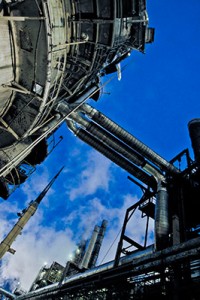Even Expensive Catalyst Designed for High Pressure ULSD Units will Underperform in a Hydrogen Starved Unit
George Hoekstra, Hoekstra Trading LLC
Over the past few years, there have been many field failures in ultra‐low sulfur diesel (ULSD) hydrotreaters. By field failures we mean short cycles of less than half the expected cycle life. The root cause of these failures was overestimating what a catalyst can do in a hydrogen starved unit. For example, one unit experienced a cycle life of just one year versus an estimated three year life on a very expensive catalyst.
After two more short cycles of less than one year on other expensive catalysts, a new catalyst supplier was brought in with no better results. After recognizing that the unit was actually hydrogen starved, the unit is now being managed against the known hydrogen constraint. Hydrogen supply has been supplemented, more difficult feeds are being processed, cycle life of 18 months has been achieved, and catalyst cost has been reduced by $2.0 million per year.
The same basic story of overpromising on catalyst performance occurred in five other known cases last year. Three of those were in refineries that have since been shut down for poor economic performance. These stories, and other “war stories” of success and failure in the field, have been told first hand by those directly involved during semi‐annual gatherings of the clients of Hoekstra Trading’s independent catalyst testing program.
Some expensive catalysts that are very good for ULSD at high pressure are not good at all at low pressure. This sensitivity to pressure is very important when choosing catalysts for low pressure units. It is also important for high pressure units that experience periods of hydrogen starvation due to frequent unit upsets, difficult feeds, or unreliable hydrogen supply. Such units often do not realize the expected benefits of the most expensive high activity catalysts.
It is increasingly common for refiners to push their units to their limits when making ULSD. High end point feeds, syncrudes, visbreaker, and coker distillates are very profitable feeds for ULSD production, but they contain more difficult sulfur, nitrogen and aromatics. These feeds can usually be handled profitably in controlled concentrations with moderate increases in reactor temperature; but there is a threshold concentration above which no ULSD catalyst will meet performance criteria.
When units are pressed to their limits with difficult feeds at low hydrogen partial pressure, desulfurization is constrained by aromatics saturation equilibrium. At this point, increasing reactor temperature actually reverses desulfurization reactions leading to a death cycle. Today’s high‐performance catalysts are excellent investments if the hydrotreating unit has the horsepower to use the kinetic capacity they provide. But when the unit is going to operate near a feed‐stressed or hydrogen starved condition, it is better to choose a catalyst that performs well at low pressure and take steps to manage the hydrogen constraint, rather than buy your catalyst supplier’s latest hot product.
The Author
George Hoekstra is president and CEO of Hoekstra Trading LLC. He retired from BP in 2009 after 35 years in refinery process research and technology management. Hoekstra now offers consulting services to independent refiners in the field of hydroprocessing catalysts (george.hoekstra@hoekstrading.com).








Leave a Reply
You must be logged in to post a comment.